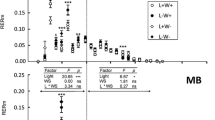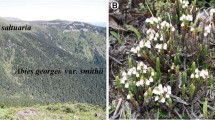Abstract
We examined the effects of shoot position on shoot growth and morphology of Avicennia marina (Forssk.) Vierh. in the Red Sea coastal region of Egypt. To determine differences in morphological characteristics, we collected shoots from the upper and lower canopies of A. marina individuals in the wild and compared the morphological characteristics of these shoots. The study plot was established in an A. marina mangrove forest. Heights and diameters of individual trunks (n = 14) in the plot were measured at ground level. Then, five shoots with young but fully expanded leaves were collected from the upper and lower canopies of the individuals. We measured shoot length, and dry weight and also area, dry weight, thickness, and Soil Plant Analysis Development (SPAD) value of collected leaves. Our measurements showed that leaf area, dry weight, specific leaf area, and SPAD value of leaves from the upper canopy were smaller than those of lower-canopy leaves in most individuals. From the differences in traits between upper and lower leaves, we concluded that leaves in the upper canopy are typically adapted to high light levels, whereas leaves in the lower canopy exhibit adaptations to low light conditions. In addition, soil-water salinity at the study site was far higher than the optimum salinity for A. marina. Hence, it is also suggested the salinity level at this site may have influenced the reduced leaf size in the upper canopy.







Similar content being viewed by others
References
Araus JL, Hogan KP (1994) Leaf structure and patterns of photoinhibition in two neotropical palms in clearings and forest understory during the dry season. Am J Bot 81:726–738
Ball MC (1988) Salinity tolerance in the mangroves Aegiceras corniculatum and Avicennia marina I. Water use in relation to growth, carbon partitioning and salt balance. Aust J Plant Physiol 15:447–464
Camilleri JC, Ribi G (1983) Leaf thickness of mangroves (Rhizophora mangle) growing in different salinities. Biotropica 15:139–141
Cheng XB, Wu J, Han JS, Zhou MY, Wang XX, Wang GC, Zhao J, Hu HQ (2012) Photosynthesis, leaf morphology and chemistry of Pinus koraiensis and Quercus mongolica in broadleaved Korean pine mixed forest. Photosynthetica 50:56–66
Clough BF (1984) Growth, salt balance of the mangroves, Avicennia marina (Forsk.) Vierh. and Rhyzophora stylosa Griff. in relation to salinity. Aust J Plant Physiol 11:419–430
Dahdouh-Guebas F, Mathenge C, Kairo JG, Koedam N (2000) Utilization of mangrove wood products around Mida Creek (Kenya) amongst subsistence and commercial users. Econ Bot 54:513–527
Dahdouh-Guebas F, Jayatissa LP, Nitto DD, Bosire JO, Seen LD, Koegam N (2005) How effective were mangroves as a defense against the recent tsunami? Curr Biol 15:443–447
Downton WJS (1982) Growth and osmotic relations of the mangrove Avicennia marina, as influenced by salinity. Aust J Plant Physiol 9:519–528
Edwards AJ, Head SM (1987) Key environment: red sea. Pergamon Press, Headington Hill Hall, Oxford 451 pp
EEAA (1998) Red Sea coastal and marine protected area stratey, Part 1: Strategy development. Egyptian Red Sea coastal and marine resource management project. Tourist Development Authority, Cairo
Evans JR, Poorter H (2001) Photosynthetic acclimation of plants to growth irradiance: the relative importance of specific leaf area and nitrogen in maximizing carbon gain. Plant Cell Environ 24:755–767
FAO (1994) Food and Agriculture Organization, Mangrove forest management guidelines. FAO Forestry Paper 117. FAO, Rome
Fu QS, Zhao B, Wang YJ, Ren S, Guo YD (2010) Stomatal development and associated photosynthetic performance of capsicum in response to differential light availabilities. Photosynthetica 48:189–198
Ha HT, Duarte CM, Tri NH, Terrados J, Borum J (2003) Growth and population dynamics during early stages of the mangrove Kanedelia candel in Halong Bay, North Viet Nam. Estuar Coast Shelf Sci 58:435–444
Hubbard RM, Bond BJ, Ryan MG (1999) Evidence that hydraulic conductance limits photosynthesis in old Pinus ponderosa trees. Tree Physiol 19:165–172
Koch GW, Sillett SC, Jennings GM, Davis SD (2004) The limits to tree height. Nature 428:851–854
Koike T, Kitao M, Maruyama Y, Mori S, Lei TT (2001) Leaf morphology and photosynthetic adjustments among deciduous broad-leaved trees within the vertical canopy profile. Tree Physiol 21:951–958
Koppen K (1931) Grundriss der Klimakunde. W. de Gruyter, Berlin
Korner C (1993) Scaling from species to vegetation: the usefulness of functional groups. In: Schulze ED, Mooney HA (eds) Springer, Berlin, pp 117–140
Krause GH, Koroleva OY, Dalling JW, Winter K (2001) Acclimation of tropical tree seedlings to excessive light in simulated tree-fall gaps. Plant Cell Environ 24:1345–1352
Lambers H, Chapin FS III, Pons TL (1998) Plant physiological ecology. Springer, New York
Larcher W (2003) Physiological plant ecology, 4th edn. Springer, New York
Lavinsky AO, Sant’Ana CS, Mielke MS, Almedida AAF, Gomes FP, Franca S, Silva DC (2007) Effects of light availability and soil flooding on growth and photosynthetic characteristics of Genipa americana L. seedlings. New Forest 34:41–50
Mazda Y, Magi M, Ikeda Y, Kurokawa T, Asano T (2006) Wave reduction in a mangrove forest dominated by Sonneratia sp. Wetl Ecol Manag 14:365–378
Moustafa MF (2007) Mangrove Final Report. Ministry of State for Environment, Egyptian Environmental Affairs Agency, Nature Conservation Sector
Naidoo G (2006) Factors contributing to dwarfing in the mangrove Avicennia marina. Ann Bot 97:1095–1101
Naidoo G (2009) Differential effects of nitrogen and phosphorus enrichment on growth of dwarf Aviccenia marina mangroves. Aquat Bot 90:184–190
Naidoo G (2010) Ecophysiological differences between fringe and dwarf Avicennia marina mangroves. Trees 24:667–673
Naidoo G, Tuffers AV, von Willert DJ (2002) Changes in gas exchange and chlorophyll fluorescence characteristics of two mangroves and a mangrove associate in response to salinity in the natural environment. Trees 16:140–146
Naidoo G, Hiralal O, Naidoo Y (2011) Hypersalinity effects on leaf ultrastructure and physiology in the mangrove Avicennia marina. Flora 206:814–820
Naidu SL, DeLucia EH (1998) Physiological and morphological acclimation of shade-grown tree seedlings to late-season canopy gap formation. Plant Ecol 138:27–40
Paliyavuth C, Patanaponpaiboon P, Ninomiya I (2009) Responses of gas exchange characteristics and morphological features of two mangrove species, Avicennia alba and Bruguiera gymnorrhiza, to different salinity and light environments. Tropics 18:23–33
Parvaresh H, Abedi Z, Farshchi P, Karami M, Khorrasani N, Karbassi A (2011) Bioavailability and concentration of heavy metals in the sediments and leaves of grey mangrove, Avicennia marina (Forsk.) Vierh, in Sirik Azini Creek, Iran. Biol Trace Elem Res 143:1121–1130
Ryan MC, Yoder BJ (1997) Hydraulic limits to tree height and tree growth. Bioscience 47:235–242
Schmitz N, Robert EM, Kirauni HA, Beeckman H, Koedam N (2009) Salinity fluctuations in the mangrove forest of Gazi Bay, Kenya: lessons to take for future research. Nat Faune 24:89–95
Sobrado MC, Ball MC (1999) Light use in relation to carbon gain in the mangrove, Avicennia marina, under hypersaline condtions. Aust J Plant Physiol 26:245–251
Tomlinson PB (1986) The botany of mangroves. Cambridge University Press, Cambridge
Tuan MS, Ninomiya I, Ogino K (1996) Effect of different levels of external salinity on germination, growth and photosynthesis in a mangrove, Avicennia marina. Tropics 6:39–50
Valladares F, Niinemets U (2008) Shade tolerance, a key plant feature of complex nature and consequences. Annu Rev Ecol Evol Syst 39:237–257
Walters RG (2005) Towards an understanding of photosynthesis acclimation. J Exp Bot 56:435–447
Acknowledgments
This study was conducted as part of an assessment of human subsistence ecosystems in Arab societies. Our survey was conducted with the cooperation of the Ministry of State for Environmental Affairs, Egyptian Environmental Affairs Agency Nature Conservation Sector (NCS). The authors thank Prof. M. Fouda, Dr. M.A. Tahoon, Mr. T. Mahmoud, Mr. A.A. El Razek, Mr. M. Negm, Mr. A. Nasser, Mr. T. Kamal, Mr. A.A. Aziz, and Mr. M. Fouad for their helpful support in the field work.
Author information
Authors and Affiliations
Corresponding author
Rights and permissions
About this article
Cite this article
Teraminami, T., Nakashima, A., Ominami, M. et al. Effects of shoot position on shoot and leaf morphology of Avicennia marina in the hyperarid Red Sea coastal region of Egypt. Landscape Ecol Eng 10, 285–293 (2014). https://doi.org/10.1007/s11355-013-0224-9
Received:
Revised:
Accepted:
Published:
Issue Date:
DOI: https://doi.org/10.1007/s11355-013-0224-9




